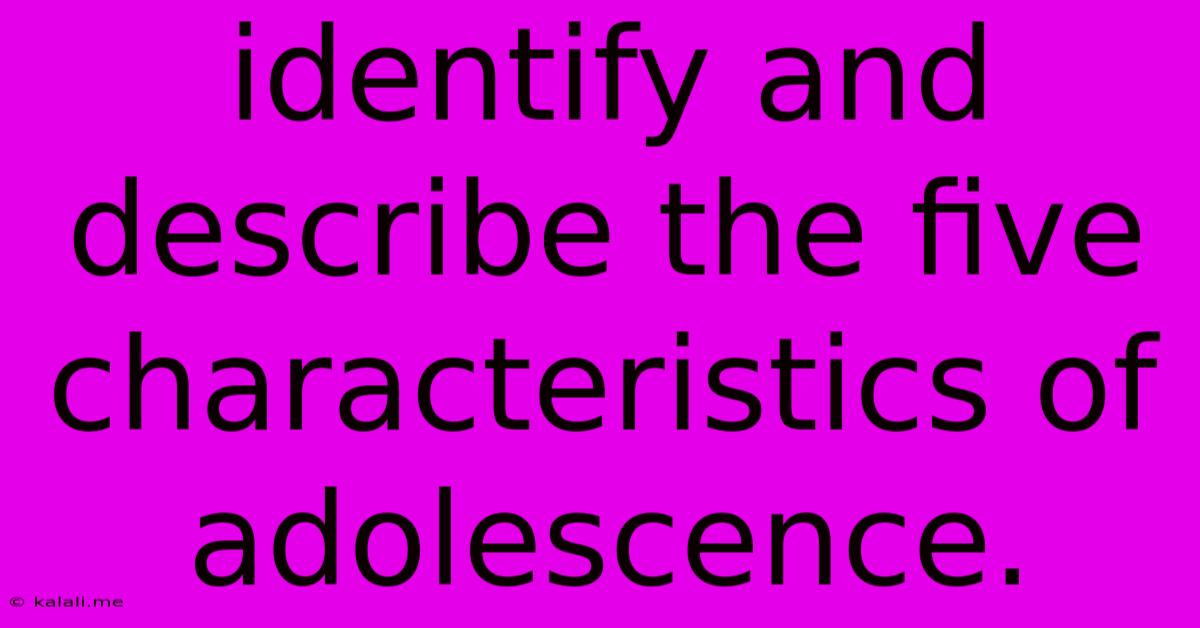Identify And Describe The Five Characteristics Of Adolescence.
Kalali
Jun 15, 2025 · 4 min read

Table of Contents
Identify and Describe the Five Characteristics of Adolescence
Adolescence, the transitional period between childhood and adulthood, is a complex and fascinating phase of human development. Characterized by significant physical, cognitive, and psychosocial changes, understanding its key characteristics is crucial for parents, educators, and healthcare professionals alike. This article will delve into five defining characteristics of adolescence, providing a comprehensive overview of this pivotal life stage. These characteristics are interconnected and influence each other, creating a unique and sometimes challenging experience for adolescents and those around them.
What is Adolescence? Adolescence is generally considered to span from the ages of 10 to 19, encompassing puberty and the journey towards independent adulthood. It's a period of rapid growth and development, marked by both exciting opportunities and significant challenges.
Five Key Characteristics of Adolescence:
1. Biological Changes: Puberty and Physical Development
The most immediately noticeable characteristic of adolescence is the onset of puberty. This biological process triggers a cascade of physical changes, including:
- Rapid growth spurts: Adolescents experience significant increases in height and weight, often unevenly distributed.
- Sexual maturation: The development of secondary sexual characteristics, such as breast development in girls and facial hair in boys, signifies the body's preparation for reproduction. This also includes the onset of menstruation and the production of sperm.
- Hormonal fluctuations: The hormonal changes during puberty can significantly impact mood, behavior, and emotional regulation. These fluctuations can contribute to mood swings and emotional volatility.
- Changes in body composition: Body fat distribution and muscle mass change, impacting body image and self-esteem. This can lead to concerns about appearance and body image issues.
Understanding these physical changes is critical for supporting adolescents' emotional well-being and addressing potential concerns related to body image and self-esteem.
2. Cognitive Development: Abstract Thinking and Reasoning
Adolescence marks a significant shift in cognitive abilities. Piaget's theory of cognitive development places adolescents in the formal operational stage, characterized by:
- Abstract thinking: The ability to think hypothetically, consider possibilities, and engage in abstract reasoning. This enables them to ponder philosophical questions and explore complex ideas.
- Logical reasoning: Adolescents become capable of deductive reasoning and problem-solving, applying logic to complex situations.
- Metacognition: Increased self-awareness of their own thinking processes allows for better planning and strategic thinking. They can reflect on their own learning styles and strategies.
- Improved information processing: Their cognitive capacity expands, enabling them to handle more complex information and multitask more effectively.
These cognitive advances allow adolescents to engage in more sophisticated learning and problem-solving, but they also contribute to increased introspection and self-consciousness.
3. Psychosocial Development: Identity Formation and Social Relationships
Adolescents grapple with significant psychosocial challenges, primarily focused on:
- Identity formation: Erik Erikson's theory emphasizes the adolescent's quest for identity, exploring different roles and values to establish a sense of self. This is a process of self-discovery and experimentation.
- Peer relationships: Peer groups become increasingly important, providing a sense of belonging and shaping social identity. Conformity to peer norms is a common characteristic of this stage.
- Family relationships: The adolescent-parent relationship often undergoes significant changes, marked by increased autonomy seeking and conflict. Navigating these shifts is a critical developmental task.
- Romantic relationships: The exploration of romantic relationships begins, further contributing to identity formation and social development. These relationships can be intensely emotional and influential.
Successfully navigating these psychosocial challenges is essential for developing healthy self-esteem, strong social skills, and fulfilling relationships.
4. Emotional Development: Increased Volatility and Self-Awareness
Emotional development during adolescence is marked by:
- Increased emotional intensity: Mood swings and emotional volatility are common due to hormonal changes and the challenges of navigating social and identity issues.
- Improved emotional regulation: While emotions are intense, adolescents gradually learn to regulate their emotional responses more effectively. This is an ongoing process that improves with age and experience.
- Increased self-awareness: Adolescents become more aware of their own emotions and their impact on others. This growing self-awareness contributes to greater emotional maturity.
- Development of empathy: Their capacity for empathy and understanding others' perspectives increases, influencing their social interactions and relationships.
Understanding these emotional shifts is crucial for providing support and guidance during this period of intense emotional growth.
5. Moral Development: Development of Ethical Reasoning
Adolescents develop a more sophisticated understanding of morality, moving towards:
- Abstract moral principles: They begin to consider ethical principles beyond concrete rules, engaging in more complex moral reasoning.
- Developing personal values: They actively shape their own values and beliefs, reflecting on their moral compass and beliefs.
- Increased social responsibility: Adolescents often demonstrate a growing concern for social justice and broader societal issues.
- Understanding consequences: Their understanding of the consequences of their actions becomes more nuanced and complex.
This development of moral reasoning lays the foundation for responsible adulthood and ethical decision-making.
In conclusion, adolescence is a dynamic period characterized by significant biological, cognitive, psychosocial, emotional, and moral transformations. Understanding these five key characteristics is vital for supporting adolescents as they navigate this challenging yet crucial phase of development. Providing a nurturing and supportive environment enables them to thrive and successfully transition into adulthood.
Latest Posts
Latest Posts
-
Which Of The Following Is Not A Product Of Fermentation
Jun 15, 2025
-
Difference Between American And Indian Culture
Jun 15, 2025
-
Action Words That Start With H
Jun 15, 2025
-
Which Of The Following Is Not True About Organelles
Jun 15, 2025
-
Which Of The Following Is The Largest Unit
Jun 15, 2025
Related Post
Thank you for visiting our website which covers about Identify And Describe The Five Characteristics Of Adolescence. . We hope the information provided has been useful to you. Feel free to contact us if you have any questions or need further assistance. See you next time and don't miss to bookmark.